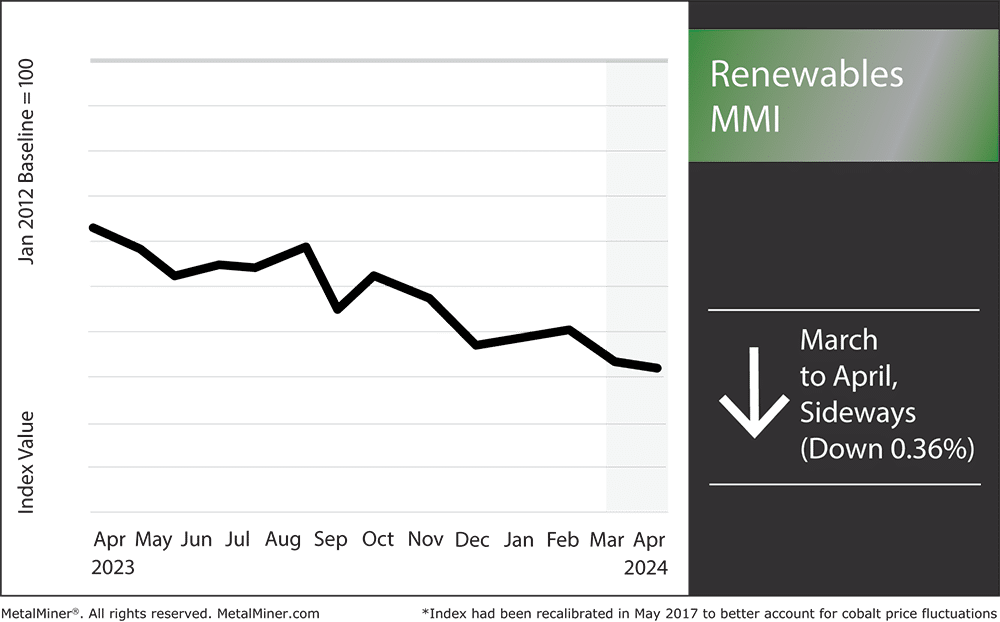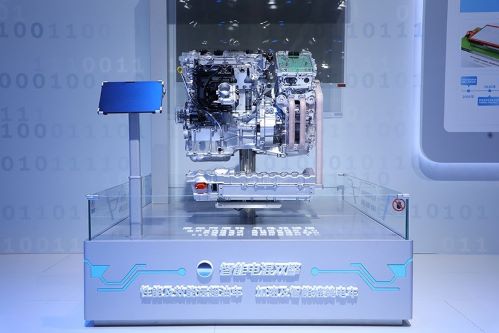The Renewables MMI (Monthly Metals Index) slowed its decline and began flattening out. Overall, the index dropped a slight 0.36%, demonstrating sideways price action month-on-month. Most index components, such as silicon and cobalt, experienced minimal downward movement without much price volatility. However, renewable resource news sources also indicated several notable factors that could impact future renewable energy commodity prices, such as renewable energy projects potentially facing funding complications
MetalMiner can unlock customizable price forecasting for your unique metals, forms, and gauges. View our full metals catalog.

Renewable Resource News Indicates that the U.S. Faces Green Energy Challenges
Even with the number of renewable energy installations in the U.S. rising quickly, the businesses spearheading this shift could face financial difficulties.
Over the past few years, a combination of increased investor interest, cost reductions, and legislative backing resulted in vast solar and wind power development. In fact, the International Energy Agency projects solar output to rise at a pace of 25% annually until at least 2030.

However, a fresh set of difficulties facing the renewable energy sector continues to strain manufacturers and project developers. According to the latest renewable resource news, the growing cost of capital resulting from higher interest rates outside of China and higher financing costs, is one of the main problems.
This is especially troublesome for renewable energy projects due to their having large upfront expenditures that are eventually offset by reduced operational costs. Furthermore, renewable energy projects continue to encounter more price disruptions. This is in addition to the greater cost of financing due to high interest rates in the U.S., which experts predict the Fed won’t begin lowering until the second half of 2024.
“Green Rush” or “Green Bust”?
There’s a sense of urgency that, if not carefully controlled, the renewable transition might result in blunders over the rush to gain government funds for sustainable energy and infrastructure projects. This is especially true of those facilitated through programs like the Bipartisan Infrastructure Law and the Inflation Reduction Act.
To enable the smooth deployment of renewable energy, state and local governments must concentrate on developing a compelling business case, selecting the best sites, and ensuring that necessary infrastructure, such as transmission lines and grid improvements, remains in place.
Despite these challenges, the long-term outlook for renewable-based commodities still remains more bullish than bearish.

Grain Oriented Electrical Steel MMI
Overall, the Grain Oriented Electrical Steel MMI experienced more heavy downward price action month-on-month, falling by 13.26%.

An Explanation on Grain Oriented Electrical Steel Price Volatility
Grain oriented electrical steel (GOES) prices have experienced significant volatility in recent years, driven by a confluence of factors impacting global supply dynamics.
One one the main contributing elements is the intermittent availability of GOES, which tends to exacerbate price volatility. Plant closures, limitations on manufacturing capacity, and logistical difficulties are just some of the factors that occasionally result in supply shortages and price spikes. On the other hand, as with any commodity based on metals, times of excess inventory can also lead to price volatility.

Furthermore, the need to upgrade the aging power infrastructure in the U.S. and the growing market for electric vehicles have both contributed to price fluctuations by driving higher demand. Moreover, it is often challenging for manufacturers to keep up with changes in demand, which leads to market imbalances and price adjustments.
To mitigate these issues, industry participants must continue to investigate hedging techniques, long-term supply contracts, and the creation of more robust supply networks to lessen the impact of GOES price volatility.
Renewables Resource News: Noteworthy Price Shifts
Subscribe to MetalMiner’s free Monthly Metals Index report and leverage it as a valuable resource for tracking and predicting renewable resource news and price trends.
- Cobalt prices moved sideways, dropping a slight 1.23% to $27.91 per kilogram.
- Silicon prices moved down 4.43% to $1894.93 per metric ton.
- Finally, steel plate also dropped. In total, prices fell 4.58% to $1291 per metric ton.




